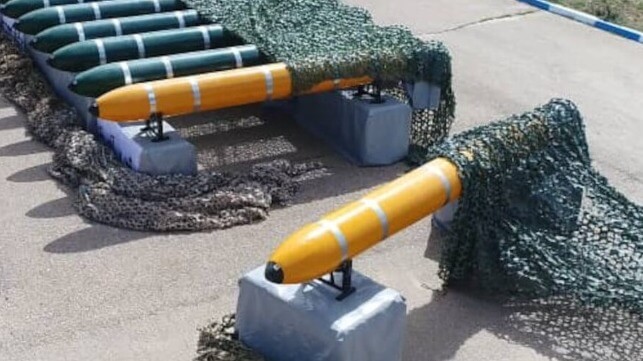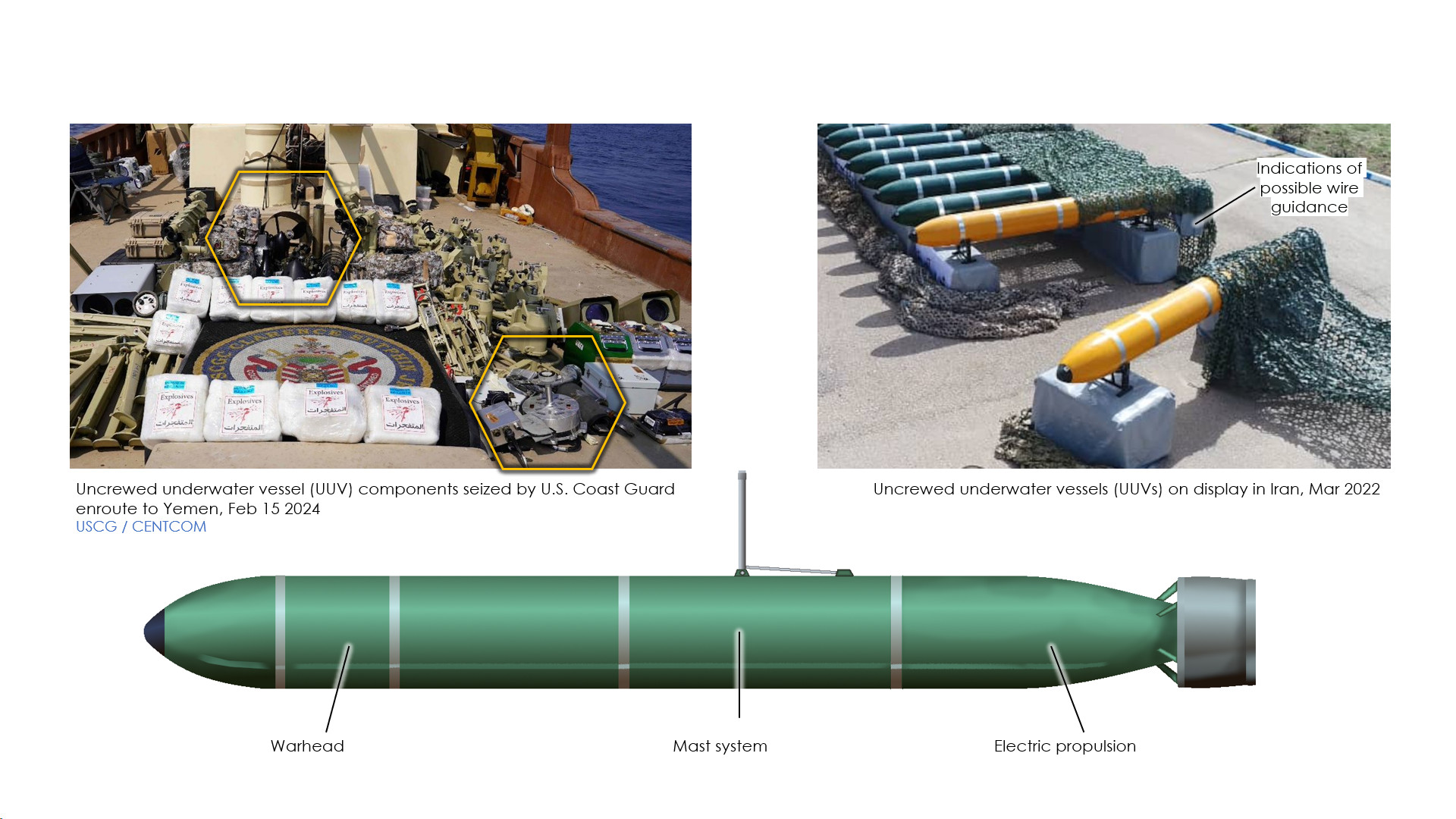 |
| Iran's Islamic Revolutionary Guard Corps
displays a new model of torpedo-shaped drone submersible. Iran provides advanced weaponry to the Houthi movement (IRGC file image) |
Summary
The threat posed by Houthi rebels in Yemen deploying unmanned undersea vehicles (UUVs) in the Red Sea will make it difficult to defend international shipping. Key points:
- The Red Sea is a vital trade route, with significant energy resources transiting through it.
- Houthi UUVs, while less sophisticated than military submarines, pose a challenge to naval operations primarily designed to counter surface and aerial threats.
- The operational range, payload capacity, and guidance systems of Houthi UUVs are unknown, but even modest capabilities could enable them to target commercial shipping.
- Traditional naval defenses are largely ineffective against UUVs, necessitating the adaptation of mine countermeasures, anti-submarine warfare capabilities, and improved intelligence sharing among coalition forces.
- The presence of undersea threats is disruptive and can have cascading effects on global economies and supply chains.
- Adapting to the UUV threat requires investing in advanced drone detection, undersea surveillance systems, and fostering international cooperation in addressing emerging maritime threats.
- The Red Sea crisis serves as a pivotal moment in the evolution of maritime security, underscoring the need for continuous adaptation and innovation in naval warfare.
A New Threat in the Red Sea: Houthi UUVs
The Red Sea, a narrow waterway snaking between Africa and the Arabian Peninsula, serves as a vital route for global trade. Significant energy resources transit the Red Sea, including an estimated 12 percent of total seaborne-traded oil in the first half of 2023, and liquefied natural gas (LNG) shipments that account for about 8 percent of worldwide LNG trade. However, this crucial passage now faces a new and unexpected threat – Unmanned Undersea Vehicles (UUVs) deployed by the Houthi rebels in Yemen.
The Houthis’ use of UUVs marks a significant escalation in the ongoing Red Sea crisis. These submersible drones, while not as sophisticated as military submarines, pose a significant challenge to naval operations designed primarily to counter surface and aerial threats. The emergence of the Houthi UUVs threat necessitates a comprehensive reassessment of the naval defense strategies and tactics being employed in the Red Sea.
How can coalition forces adapt Red Sea operations to enhance undersea defense against unconventional threats such as Houthi UUVs? What steps are required to restore stability in the Red Sea region, emphasizing a decisive response to the Houthi UUVs threat? Furthermore, how must global navies adapt their warfighting techniques to effectively counter the distinct challenges posed by these emerging undersea threats?
By effectively addressing these critical questions, the international community can ensure the safety of vital sea lanes in the Red Sea and establish a framework for countering emerging undersea threats in the future.
Houthi UUV Capabilities and the Evolving Threat
The Houthi rebels in Yemen have injected a new and unsettling element into the Red Sea’s already tense security landscape. In March three undersea telecommunication cables were cut in the Red Sea, which the Houthis have denied doing, but nonetheless suggests a contested undersea domain. While details about Houthi UUVs remain murky, open-source intelligence suggests they are likely commercially-adapted or relatively unsophisticated submersible drones. Despite their presumed lack of sophistication compared to military submarines, these low-cost UUVs pose a significant threat due to several key factors.
The operational range and payload capacity of Houthi UUVs are currently unknown. However, even a modest range, measured in tens of miles, could enable them to target commercial shipping within the Red Sea. Their potential payload could include mines, torpedoes, or explosives packed into the hull, possibly enough to inflict significant damage on unsuspecting commercial vessels.
Houthi UUVs likely lack sophisticated guidance and targeting systems compared to military-grade undersea drones. They may rely on basic GPS or pre-programmed routes, as well as wire guidance. However, this simplicity can also make them difficult to detect and eliminate before they reach their targets.
Traditional naval defenses designed to counter surface and aerial threats are largely ineffective against undersea drones. Sonar technology and undersea surveillance systems are crucial for detecting and tracking UUVs. The preferable escort and maneuver patterns of warships searching for undersea threats may be at odds with the operational patterns that optimize air defense coverage, potentially creating difficult tradeoffs and tensions. This can create a significant challenge for the international coalition forces operating in the Red Sea.
The impact of Houthi UUVs extends far beyond potential damage to individual ships. The very presence of undersea threats is disruptive, given how the stealth of undersea platforms can magnify the effects of their operations and substantially shape the behaviors of those under threat. According to a recent report by the Global Trade Research Institute, even minor disruptions to Red Sea shipping could have a cascading effect on economies in Asia, Africa, and Europe. The specter of undersea threats can stimulate outsized uncertainty and risk, potentially driving up insurance costs and impacting global supply chains further.
Responses and Challenges in a Multi-Domain Environment
Faced with Houthi UUVs lurking beneath the waves, the international coalition in the Red Sea is grappling with a new and demanding challenge. However, the coalition is not without options. There are various strategies and capabilities that can be employed by coalition forces.
Mine Countermeasures warships (MCMs) are crucial for clearing mines potentially deployed by the Houthis, which can be deployed by the UUVs in sea lanes and also deployed near the UUV launch sites. The sonar and mine disposal capabilities of MCM ships can play a vital role in safeguarding sea lanes and improving undersea domain awareness.
Anti-Submarine Warfare (ASW) capabilities can be adapted to the UUV fight, including sonobuoys, towed array sonars, dipping sonars, and deployable hydrophone arrays. These tools can help create a more comprehensive undersea surveillance network in the Red Sea and gather critical intelligence on the telltale signatures of UUVs. An undersea surveillance network can be useful for cueing UUV hunters toward detections, rather than relying hunters to find UUVs using only their organic sensors.
The information-intensive nature of surveilling the complex undersea domain demands thoughtful approaches to intelligence coordination. Information sharing and collaboration among coalition members is critical for locating Houthi UUVs. Real-time data exchange can help predict potential attacks and enable a more coordinated response. Faster reaction times and improved targeting capabilities could potentially be used to intercept Houthi support vessels or launch platforms before they deploy UUVs. Ultimately coalition forces can aspire to strike Houthi UUVs before they are ever deployed by degrading their enabling infrastructure.
Despite the possibility of adaptation, current undersea surveillance capabilities may not be optimal for detecting low-signature Houthi UUVs, particularly in the acoustic environment of the Red Sea. The maritime shipping that continues to transit may transmit significant sound into the undersea environment that complicates UUV hunting, especially as a UUV nears a target merchant vessel. Advanced undersea drones and sensor networks specifically designed for UUV detection are urgently needed. Employing new tactics for UUV detection, engagement, and neutralization will require tailored training and exercises that realistically simulate hostile UUV encounters.
Conclusion
The Red Sea crisis serves as a pivotal moment in the evolution of maritime security. The lessons learned here – the importance of adapting naval power, the dangers of escalation, and the necessity of international cooperation – will reverberate far beyond the shores of this strategically vital waterway. By embracing innovation, fostering collaboration, and developing effective strategies for the undersea battlefield, the international community can ensure the safety and security of global trade routes and navigate the challenges of the 21st-century maritime security landscape.
Forces must consider what adaptations can meet the emerging UUV threat. Investing in cutting-edge drone detection and undersea surveillance systems is crucial for creating a comprehensive UUV defense network. Research and development efforts should focus on advanced sonar technologies and autonomous undersea vehicles (AUVs) specifically designed for UUVs countermeasures. Improved intelligence gathering and information sharing among coalition partners is essential for tracking UUVs and anticipating potential attacks. This includes intelligence cooperation with regional partners and leveraging advanced surveillance technologies.
The Red Sea crisis underscores the importance of international cooperation in addressing emerging maritime threats. Sharing best practices, conducting joint training exercises, and fostering closer collaboration on technology development are all crucial steps towards a more robust response to UUVs. The Houthi UUV threat offers a stark reminder of the need for continuous adaptation and innovation in the realm of naval warfare. Long-theorized unmanned undersea threats have now arrived.
Commander Amila Prasanga, Sri Lankan Navy, is Military Research Officer at the Institute of National Security Studies, the premier Sri Lankan think tank on national security, established and functioning under the Sri Lankan Ministry of Defence. The opinions expressed are his own and are not necessarily reflective of the official views of the institute or the Ministry of Defence.
This article appears courtesy of CIMSEC and may be found in its original form here.
The opinions expressed herein are the author's and not necessarily those of The Maritime Executive.

Merchant ships and warships in the Red Sea have been under frequent attacks from anti-ship cruise missiles, anti-ship ballistic missiles, explosive surface drones, and aerial drones. Now a new threat has emerged from underwater.
On Feb. 18, U.S. Central Command announced naval forces in the Red Sea destroyed an uncrewed underwater vehicle (UUV) in Houthi-controlled waters around Yemen. This is the first time that the Houthi Movement has been observed operating UUVs since attacks began last October.
Just a few days earlier, CENTCOM issued a press release about the January U.S. Coast Guard interdiction of a weapons shipment from Iran to the Houthis in Yemen. The catch included components for uncrewed surface vessels (USVs) and, notably, uncrewed underwater vehicles (UUVs), according to the photos released by CENTCOM. The weapon seizure connects Houthi’s UUV threat to Iranian-supplied vehicles and techniques.
Iran has a long tradition of unconventional naval warfare which has become more refined in recent years. Many of these platforms are now uncrewed, including boats, aerial drones and underwater drones, based on images systems released by the Iranian government. Hamas has also touted its possession of UUVs in Gaza, according to images the armed group released in November as reported by Naval News.
The U.S, has not released details about the UUV destroyed by U.S. forces this week or the parts seized. The photographs released show a propeller (screw) section that is consistent with UUVs used by Iran.
The UUV, along with those seen in Iran, appears similar to a torpedo. orone-way attack underwater drone (OWA-AUVs). Generally, these have a greater range than a torpedo but are slower, making them most effective against static targets such as ships in port or at anchor. The type typically used in Iran, according to observers, can be fitted with a short mast, possibly to observe the target before attacking. It is possible that the device can be remotely operated by a wire, similar to wire-guided torpedoes. This would allow it to engage moving targets.
Iran may have previously used these against tankers off the coast of the United Arab Emirates. Hamas has attempted to use similar vehicles against Israel’s offshore energy infrastructure, Israeli officials claimed in 2021.
Underwater weapons are inherently harder to detect and counter than surface vessels. They are more likely to surprise the target and can cause holes below the waterline which can be more damaging. They also require a different set of tactics for the escorting warships to counter them. Ukraine has amply demonstrated the effectiveness of explosive-laden surface drones (USVs) against Russian platforms. The Houthis have had less success, largely due to the presence of U.S. Navy and allied warships in the region.


No comments:
Post a Comment